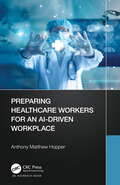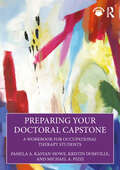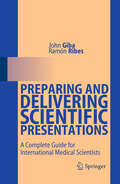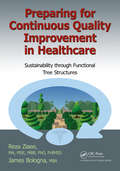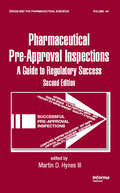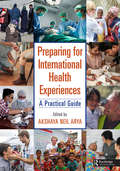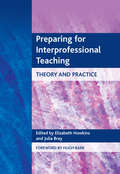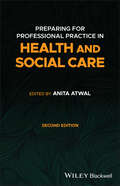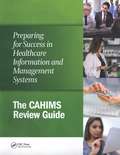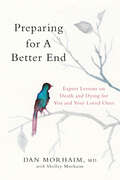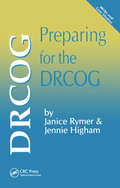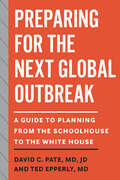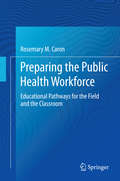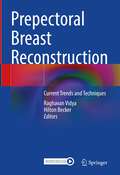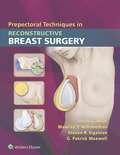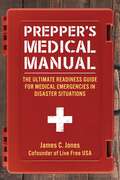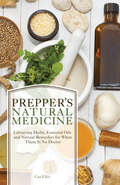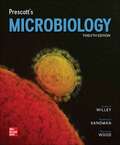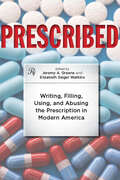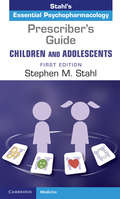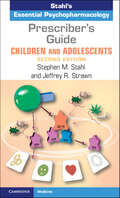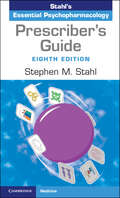- Table View
- List View
Preparing Healthcare Workers for an AI-Driven Workplace
by Anthony Matthew HopperA large number of healthcare employees, whether they are on the frontlines or in management, work in complex, fluid environments. They must perform a diverse number of sometimes intricate tasks on a daily basis as well as excel in handling ad hoc interactions with patients, residents, coworkers, or other stakeholders. In the coming years, these workers will also have to adjust to disruptions in their workplaces that are brought about by the introduction of new Artificial Intelligence (AI) systems and health information technologies (HITs) into their offices and clinics. Many of these workers will find themselves competing for jobs not only with other humans but also with machines.Preparing Healthcare Workers for an AI-Driven Workplace helps healthcare professionals to develop their core critical thinking skills while also enabling them to develop methodologies for successfully completing complex projects by themselves, dealing with ad hoc interactions, and taking advantage of the coming AI- and IT-driven changes in their workplaces. The book begins with explaining why healthcare workers, whether they work on the frontlines or in management, need to be strong critical thinkers. It breaks down “critical thinking” into its key elements and provides methods that readers can use to help them to master critical thinking and grow to become elite critical thinkers. The book also provides tips on how to handle ad hoc conversations with supervisors, coworkers, patients, residents, and other stakeholders. Examining how AI- and IT-related developments will transform the healthcare ecosystem in the coming years, the book identifies key mindsets and strategies for thriving in technologically rich healthcare environments.
Preparing Your Doctoral Capstone: A Workbook for Occupational Therapy Students
by Pamela A. Kasyan-Howe Kristin Domville Michael A. PizziThis practical and informative workbook guides occupational therapy doctorate students through every step of the capstone project and experience.The workbook acknowledges the variability in capstone requirements and supports students by providing strategies to address common components. Each chapter offers tips and advice on topics such as identifying a need, finding a mentor and experiential site, conducting a literature review, developing project objectives, developing experiential objectives, and dissemination of the outcomes. Guiding students to develop a meaningful and productive capstone project and experience, the book includes worksheets and samples of completed student projects and experiences at each stage of the process.This is the ideal guide for any occupational therapy doctorate student aiming to undertake a successful capstone project, as well as the perfect complement for Doctoral Capstone Coordinators (DCC) and didactic classroom teaching and learning.
Preparing and Delivering Scientific Presentations: A Complete Guide for International Medical Scientists
by Ramón Ribes John GibaThe latest in Springer's "Medical English" series, aimed at health care professionals who need English for their work but do not speak English on a day-to-day basis. Although much of the information provided will be useful for scientists of all backgrounds and nationalities, the book is aimed especially at non-native English-speaking physicians and biomedical scientists. It offers clear advice on a variety of topics relevant to the successful preparation and delivery of scientific presentations. Alongside guidance on the actual preparation and delivery of talks, helpful information is provided on such potential difficulties as dealing with questions, chairing sessions, and use of appropriate English. The book will offer encouragement for those embarking on a career in international science as well as practical advice on how to deal with a wide range of situations that may develop in the context of an international congress.
Preparing for Continuous Quality Improvement for Healthcare: Sustainability through Functional Tree Structures
by Reza Ziaee James S. Bologna MBAThis book provides a set of detailed instructions to help you construct your departmental, divisional, or organizational functional tree structure (FTS) and work towards world-class service. Preparing for Continuous Quality Improvement for Healthcare: Sustainability through Functional Tree Structures outlines a method that will enable your organiza
Preparing for FDA Pre-Approval Inspections: A Guide to Regulatory Success, Second Edition
by Martin D. HynesThis Second Edition is an essential guide to preparing for FDA pre-approval inspections-taking into account current trends in FDA expectations and inspection activities, such as the GMPs of the 21st Century, quality systems-based approach to inspections, risk-based inspections, quality by design, process analytical technology, design space, etc. Th
Preparing for International Health Experiences: A Practical Guide
by Akshaya Neil AryaAt some point in their careers, many health professionals and students wish to engage in overseas work. Learning from other systems, people and cultures is invaluable and in some cases life changing. This book is a unique resource that offers necessary insights into making the most of the experience, from pre-departure training through to return orientation. It provides information on navigating the legalities and bureaucracies of international medical training and gives insights into cultural and language competencies, including how to be ethical and deferential in the exchange of situational knowledge. Preparing for International Health Experiences is a must-read for any healthcare student considering volunteering, doing mission or practical work abroad. It covers specific medical professions from paediatrics to surgery, and allied disciplines such as dentistry and nursing. Its practical tips and consideration of ethical issues will be valued by readers of different levels and experience.
Preparing for Interprofessional Teaching: Pt. A, SBAs and EMQs - Mock Papers with Comprehensive Answers
by Elizabeth Howkins Julia BrayThe book provides a critical exploration of the theory and practice related to teacher preparation for interprofessional learning. It makes an important contribution to the emerging evidence base through an in-depth exploration of the processes involved in teaching complex diverse groups, facilitator preparation, curriculum development and inter-institutional collaboration. Research-based evidence from the Promoting Interprofessional Education (PIPE) project helps teachers to further understand their own practice and build their own theories of teaching interprofessional learning. The enlightening analysis is vital reading for all health and social care professionals (including allied health professionals) involved in formal learning and workplace education. Healthcare education policy makers and shapers will also find it invaluable.
Preparing for Professional Practice in Health and Social Care
by Anita AtwalPREPARING FOR PROFESSIONAL PRACTICE IN HEALTH AND SOCIAL CARE The new edition of Preparing for Professional Practice in Health and Social Care is a welcome resource for students and newly registered Allied Health professionals, emphasising client-centered practice while clarifying expectations from regulatory bodies such as the Health and Care Professions Council (HCPC). The book presents a range of topics—such as law, ethics, interprofessional working, leadership, equality and diversity, team building, communication skills, and reflective practice—ensuring readers are fully prepared for the demands of their profession. Readers will also find: Practical guidance on getting, and keeping, the job – from writing a CV, applying for jobs, interview techniques, as well as career-planning and continuing professional development Each chapter begins with an overview of the content and concludes with key take-home messages and further reading suggestions A set of self-assessment exercises Case studies and examples from clinical practice Preparing for Professional Practice in Health and Social Care is a useful reference for all Allied Health professionals.
Preparing for Success in Healthcare Information and Management Systems: The CAHIMS Review Guide (HIMSS Book Series)
by HimssHIMSS’ Certified Associate in Healthcare Information and Management Systems (CAHIMS) certifi cation offers a pathway to careers in health information technology (health IT) for associate-level, emerging professionals, or those who would like to transition to health IT from other industries. The CAHIMS Review Guide is the ideal resource for those preparing for the CAHIMS Certifi cation Exam—or looking for a comprehensive ‘health IT 101’ guide. Content in the CAHIMS Review Guide reflects the CAHIMS exam content outline. Content is divided into three topic categories: organizational and technology environments; systems analysis, design, selection, implementation, support, maintenance, testing, evaluation, privacy and security; and leadership and management support. Each chapter includes learning objectives for tracking progress in understanding and articulating the content. Practice exam questions at the end of the book reinforce key concepts explored throughout the book. The CAHIMS Review Guide also features a glossary of acronyms used throughout the book for easy reference during exam preparation and ‘on the job’ reference after certification.
Preparing for a Better End: Expert Lessons on Death and Dying for You and Your Loved Ones
by Dan MorhaimA vital roadmap to planning your own end-of-life care.While modern Americans strive to control nearly every aspect of their lives, many of us abandon control of life's final passage. But the realities of twenty-first-century medicine will allow most of us to have a say in how, when, and where we die, so we need to make decisions surrounding death, too. Or those decisions may be made for us. Threading compelling real-life stories and practical guidance throughout, this book helps readers navigate end-of-life care for themselves and their loved ones.In this practical guidebook, Dr. Dan Morhaim and Shelley Morhaim offer readers hope, empowerment, and inspiration. What we choose for our end-of-life care, they assert, depends on accurate information and on our personal values. We need these not only to understand new medical advances but also to appreciate the wisdom of humanity's past and present. Dan Morhaim, an emergency medicine physician and former Maryland state legislator, guides readers through the medical, legal, and financial maze of end-of-life care. He details the care choices available to patients and explains why living wills and advance directives are a necessity for every American. He tells readers where to find free and readily available living wills and advance directives and why it is so important for everyone—young and old—to complete them. Meanwhile, Shelley Morhaim draws on her experience as a therapeutic music practitioner for hospice and hospital patients to offer compassion to readers facing hard decisions.The authors reflect on a number of timely topics, including• what doctors—including Dr. Morhaim specifically—want for themselves in terms of end-of-life care• how legislative initiatives on assisted dying vary by state• how to obtain medical orders for life-sustaining treatment (MOLST/POLST)• how to deal with dementia• what to expect from palliative and hospice care• how to cope with pain at the end of life, including with medical cannabis and narcotics• how organ donation and body disposition work• how to communicate individual needs to lawyers, physicians, and family members• how to make decisions when selecting the best care for yourself and othersand more.Organized as a roadmap that people should follow when they plan end-of-life care and contingencies, this book helps readers keep decisions in their own hands and spare their families the uncertainty and trauma of guessing about their end-of-life wishes. Breaking down the barriers to a difficult but essential topic, Preparing for a Better End helps readers open this often-avoided discussion with their loved ones while providing the information and guidance needed to ensure that deeply held values are reflected and honored.Praise for the Author "In The Better End, Dr. Morhaim helps the reader to see that while death does have its sting, it need not be bitter, and each of us can prepare for the end in better ways."—Maya Angelou "Dan Morhaim's message is a must read for anyone who is facing end-of-life crisis issues and concerns, whether it be for themselves or for a family member or loved one. When so many others shun away from the topic, Dan Morhaim addresses the situation with clarity, insight, and sensitivity."—Montel Williams
Preparing for the DRCOG
by Janice Rymer Jennie HighamHere is a selection of multiple choice questions and care studies designed for candidates for the Diploma of the Royal College of Obstetricians and Gynaecologists (DRCOG). The 90 multiple choice questions cove all major areas of the syllabus and are accompanied by extended answers to help the revision process. The case studies are ideal preparation for the other sections of the examination as well as for general revision. This book will be suitable not only for the DRCOG (and other examinations such as the MRCOG) but also for anyone wanting to update and test their understanding of obstetrics and gynaecology.
Preparing for the Future of HIV/AIDS in Africa: A Shared Responsibility
by Institute of Medicine of the National AcademiesHIV/AIDS is a catastrophe globally but nowhere more so than in sub-Saharan Africa, which in 2008 accounted for 67 percent of cases worldwide and 91 percent of new infections. The Institute of Medicine recommends that the United States and African nations move toward a strategy of shared responsibility such that these nations are empowered to take ownership of their HIV/AIDS problem and work to solve it.
Preparing for the Next Global Outbreak: A Guide to Planning from the Schoolhouse to the White House
by David C. Pate Ted EpperlyMedical experts on the frontlines of the COVID-19 pandemic provide recommendations for governments, health agencies, and schools to prepare for the next outbreak.Another pandemic is coming. The type, severity, and spread are unknown, but governments, public health agencies, schools, and all other organizations must be prepared in order to minimize damage and save lives. We need to identify the lessons learned from our successes and failures during the COVID-19 pandemic to plan better for our future response.In Preparing for the Next Global Outbreak, David C. Pate, MD, JD, and Ted Epperly, MD, combine their decades of experience as doctors and health care leaders who have led their organizations through numerous public health challenges to create an extensive list of practical recommendations for a variety of organizations and agencies to better prepare for the next pandemic. They worked together in the fight against COVID-19 and the misinformation that devastated so many communities across the country. From the exam room to the public health board meeting room to the state capitol, Pate and Epperly use their expertise to craft 117 specific recommendations that organizations and governments can implement now in order to better prepare for the future. They divide these recommendations into checklists specific to different contexts: schools, hospitals, public health agencies, state governments, and the federal government. Public health officials, medical practitioners, state and local officials, school board members, disaster management leaders, and anyone with a stake in preparing their communities against future outbreaks will benefit from the recommendations Pate and Epperly outline.This is the first book to apply lessons learned in real time during a pandemic while chronicling which responses did and did not work and why. The authors examine the global, national, and local responses to COVID-19 and illustrate how we can learn from the mistakes of this pandemic so as not to repeat them during the next.
Preparing the Public Health Workforce
by Rosemary M. CaronIn concept and practice, public health casts a wide net, spanning assessment, intervention, and policy; education, prevention, and protection; public, private, and government entities. But key elements are often missing from the picture, including a clear understanding of public health and its goals by the general public, and specific public health education throughout the workforce. Preparing the Public Health Workforce responds to these and related challenges by elegantly summarizing the state of the field in an era of dwindling budgets, competing and overlapping services, and a shaky professional infrastructure. In keeping with public health goals set out by the CDC and other leading agencies, the author makes a real-world case for standardizing training, establishing best practices in the field, and coordinating public health systems with their healthcare counterparts. Theory, case examples, tools, and callout boxes highlight knowledge, preparation, and skills professionals need in addressing chronic issues and complex emergencies. Throughout, the emphasis is on greater competency and visibility for the profession, resulting in a more informed, healthier public. Featured in the coverage: Issues in defining the public health workforce. The state of public health education. Practicing and teaching public health: local, national, and international cases. Standardizing public health practice: benefits and challenges. Integrating public health and healthcare. The future of public health as seen from academia and the frontlines. Identifying urgent issues and providing cogent answers, Preparing the Public Health Workforce is a call to action for those involved in creating the next level of public health, including professors, practitioners, students, and administrators.
Prepectoral Breast Reconstruction: Current Trends and Techniques
by Raghavan Vidya Hilton BeckerBreast cancer is one of the most common forms of cancer worldwide, and surgery remains the mainstay of treatment. Breast reconstruction and Oncoplastic techniques have advanced over the last decade from complex autologous reconstruction to minimal invasive surgery. Breast reconstruction has evolved from traditional submuscular techniques to prepectoral implant-based reconstruction, thanks to advances in implantable biologic and synthetic products that make this muscle-sparing approach possible. In this state-of-the art volume, prominent clinicians and the pioneers of this technique join forces to provide the reader with a practical guide to prepectoral breast reconstruction, including relevant anatomical knowledge, key skills, and concrete tips for daily practice. After discussing the historical evolution of prepectoral breast reconstruction and providing an anatomical description of the superficial fascia system, the book presents the main approaches currently available, and addresses patient selection, radiation therapy, postoperative monitoring, and particular challenges such as revision surgery. Dedicated chapters on mesh scaffolds and autologous lipomodelling are also included. The book also features over 150 original full-color illustrations and drawings, together with take-home messages. With its complete yet handy format, Prepectoral Breast Reconstruction offers a valuable reference guide for residents, fellows, practicing breast surgeons, plastic surgeons, and all professionals in related sub-specialties.
Prepectoral Techniques in Reconstructive Breast Surgery
by Allen Gabriel Maurice Y. Nahabedian Steven R. Sigalove G. Patrick MaxwellPublisher's Note: Products purchased from 3rd Party sellers are not guaranteed by the Publisher for quality, authenticity, or access to any online entitlements included with the product. The practice of tissue expander/implant based pre-pectoral breast reconstruction holds great promise for superior cosmetic results, less pain, and a shorter recovery period. Pre-Pectoral Techniques in Reconstructive Breast Surgery is the first reference to cover this timely area in depth, offering step-by-step descriptions of current procedures.
Prepositioning Antibiotics for Anthrax
by Institute of MedicineRapid access to antibiotics can prevent people who are exposed to aerosolized Bacillus anthracis from developing anthrax; once symptoms of anthrax emerge, the disease progresses rapidly and can prove fatal. Since the anthrax attack in 2001, the nation’s public health system has made great strides in developing plans to deliver antibiotics quickly to all potentially exposed people. However, concerns remain about the nation’s ability to respond to an anthrax attack scenario of the most dire proportions—for example, a large-scale attack impacting hundreds of thousands of people and carried out in multiple cities. <P> Prepositioning (storage closer to intended users, before an attack occurs) is one of the mechanisms that have been discussed over the past several years for helping to ensure that all members of a community have rapid access to medical countermeasures (MCM) such as antibiotics. Antibiotics could be prepositioned in many different venues, including local stockpiles, workplace caches, caches in health care settings, and even in the home. The Department of Health and Human Services, Office of the Assistant Secretary for Preparedness and Response, asked the Institute of Medicine (IOM) to convene a committee to examine the potential role of these different prepositioning strategies in the overall MCM dispensing strategy. The committee was tasked to examine a wide range of factors, including benefits, costs, safety, and ethical issues. <P><P> The committee found that, under particular circumstances, prepositioning strategies can reduce the time within which individuals in a community can receive prophylactic antibiotics, and certain strategies can help alleviate the burden on the public health dispensing system. Relative to existing, more centralized distribution and dispensing strategies, however, prepositioning provides less flexibility to change plans following an attack if necessary. For example, prepositioning may not be helpful if an attack occurs in a location other than anticipated or uses a strain of anthrax that is resistant to the prepositioned antibiotic. The committee also found that costs are likely to increase as antibiotics are prepositioned closer to the intended users.
Prepper's Medical Manual: The Ultimate Readiness Guide for Medical Emergencies in Disaster Situations
by James C. JonesBe Prepared to Face Any Medical Emergency With This Essential GuideWhile many first aid manuals provide valuable instructions on how to respond to various medical situations, they may not meet the needs of the average citizen preparing to meet a broad range of medical emergencies, with limited skills, limited supplies, and limited or non-existent support from the Emergency Management System and medical professionals. In this color-photo illustrated manual, veteran survivalist and trained EMT James C. Jones did not create &“just another&” first aid book. Instead, each subject is approached from the perspective of equipping the untrained citizen to provide care for family members and neighbors, under extremely trying conditions, without expert help. Prepper&’s Medical Manual includes basic first aid subjects, such as bandaging, splinting, control of bleeding, and treatment of shock, along with those subjects specifically associated with the needs of those responding to true disaster emergencies. Complete with multiple step-by-step response guides and checklists for stocking personal medical emergency kits, Prepper's Medical Manual can ensure readiness for even the worst-case scenario.
Prepper's Natural Medicine: Life-Saving Herbs, Essential Oils and Natural Remedies for When There is No Doctor (Preppers Ser.)
by Cat EllisA DEFINITIVE GUIDE TO HEALING ANY AILMENT HOLISTICALLY WHEN DISASTER STRIKES When disaster strikes and you lose all access to doctors, hospitals and pharmacies, natural medicine will be your family's best hope for survival. Prepper's Natural Medicine is the definitive guide to creating powerful home remedies for any health situation, including: *Herbal Salve for Infections *Poultice for Broken Bones *Natural Ointment for Poison Ivy *Infused Honey for Burns *Essential Oil for Migraines *Soothing Tea for Allergies *Nutritional Syrup for Flu With easy-to-read herbal charts, a breakdown of essential oils, tips for stockpiling natural medicines and step-by-step instructions for creating your own elixirs, salves and more, this book offers everything you need to keep you and your loved ones safe.
Prescott's Microbiology
by Dorothy Wood Joanne Willey Kathleen SandmanThe author team of Prescott’s Microbiology continues to provide a modern approach to microbiology using evolution as a framework. This new 12th edition integrates impactful new changes to include a fresh new design to engage students and important content updates including SARS-CoV-2 and COVID-19 which are prominently featured, taxonomic schemes that have been extensively revised, recent epidemiological data, and mRNA vaccines which just scrapes the surface of this new edition.
Prescribed: Writing, Filling, Using, and Abusing the Prescription in Modern America
by Jeremy A. Greene and Elizabeth Siegel WatkinsAmerica has had a long love affair with the prescription. It is much more than the written "script" or a manufactured medicine, professionally dispensed and taken, and worth hundreds of millions of dollars a year. As an object, it is uniquely illustrative of the complex relations among the producers, providers, and consumers of medicine in modern America. The tale of the prescription is one of constant struggles over and changes in medical and therapeutic authority. Stakeholders across the biomedical enterprise have alternately upheld and resisted, supported and critiqued, and subverted and transformed the power of the prescription. Who prescribes? What do they prescribe? How do they decide what to prescribe? These questions set a society-wide agenda that changes with the times and profoundly shifts the medical landscape. Examining drugs individually, as classes, and as part of the social geography of health care, contributors to this volume explore the history of prescribing, including over-the-counter contraceptives, the patient’s experience of filling opioid prescriptions, restraints on physician autonomy in prescribing antibiotics, the patient package insert, and other regulatory issues in medicine during postwar America.The first authoritative look at the history of the prescription itself, Prescribed is a groundbreaking book that subtly explores the politics of therapeutic authority and the relations between knowledge and practice in modern medicine.
Prescribed: Writing, Filling, Using, and Abusing the Prescription in Modern America
by Jeremy A. Greene and Elizabeth Siegel Watkins“Both the health care professional and the consumer will benefit greatly from this topical book . . . Highly recommended.” —ChoiceThe prescription is more than a piece of paper—or just as likely these days, a piece of digital data. It is uniquely illustrative of the complex relations among the producers, providers, and consumers of medicine in modern America.The tale of the prescription is one of constant struggles over—and changes in—medical and therapeutic authority. Stakeholders across the biomedical enterprise have alternately upheld and resisted, supported and critiqued, and subverted and transformed the power of the prescription. Who prescribes? What do they prescribe? How do they decide what to prescribe? These questions set a society-wide agenda that changes with the times and profoundly shifts the medical landscape. Examining drugs individually, as classes, and as part of the social geography of health care, contributors to this volume explore the history of prescribing, including over-the-counter contraceptives, the patient’s experience of filling opioid prescriptions, restraints on physician autonomy in prescribing antibiotics, the patient package insert, and other regulatory issues in medicine during postwar America.The first authoritative look at the history of the prescription itself, Prescribed is a groundbreaking book that subtly explores the politics of therapeutic authority and the relations between knowledge and practice in modern medicine.
Prescriber's Guide – Children and Adolescents: Stahl's Essential Psychopharmacology
by Stephen M. StahlChild and adolescent psychopharmacology is a rapidly growing field with psychotropic medications used widely in the treatment of this patient group. However, psychopharmacological treatment guidelines used for adults cannot simply be applied for children or adolescents, thus presenting clinicians and nurse practitioners with assessment and prescribing challenges. Based on the best-selling resource Stahl's Prescriber's Guide, this new book provides a user-friendly step-by-step manual on the range of psychotropic drugs prescribed for children and adolescents by clinicians and nurse practitioners. Reviewed by expert child and adolescent psychiatrists, the medications are presented in the same design format in order to facilitate rapid access to information. Each drug is broken down into a number of sections, each designated by a unique color background thereby clearly distinguishing information presented on therapeutics, safety and tolerability, dosing and use, what to expect, special populations, and the art of psychopharmacology, and followed by key references.
Prescriber's Guide – Children and Adolescents: Stahl's Essential Psychopharmacology
by Stephen M. StahlThis extensively revised second edition provides a user-friendly step-by-step manual on the range of psychotropic medications prescribed for children and adolescents by clinicians and nurse practitioners. Boasting nearly double the medications of the first edition, it features new sections related to pharmacokinetics and pharmacogenetics in children and adolescents alongside algorithms for addressing frequently encountered disorders such as anxiety, depression, bipolar disorder, ADHD, and OCD. Based on the best-seller, Stahl's Prescriber's Guide, and using a full-color template-driven navigation system, it combines evidence-based data with clinically informed guidance to support prescribers in the field. Each drug is presented in the same classic design format with illustrated guidance on dosing, titration, and pharmacogenetics/metabolism. Color-coded sections distinguish clearly the information presented on therapeutics, safety and tolerability, dosing and use, what to expect, and the art of psychopharmacology, and are followed by updated and new key references. A must-have guide for all mental health professionals.
Prescriber's Guide: Stahl's Essential Psychopharmacology
by Stephen M. StahlWith the range of psychotropic drugs expanding and the usages of existing medications diversifying, we are pleased to present the Eighth Edition of the world's best-selling formulary in psychopharmacology. The new edition features seven brand new compounds as well as information about several newly approved formulations of existing drugs. Many important new indications are covered for existing drugs, as are updates to the profiles of the entire content and collection, including new injectable and transdermal formulations, as well as updated warnings and indications. The icons and Pearls have been refreshed throughout, and with the book's its easy-to-use, full-colour template-driven navigation system, Prescriber's Guide combines evidence-based data with clinically informed advice to support everyone who is prescribing in the field of mental health.
